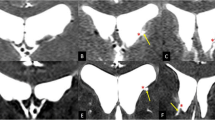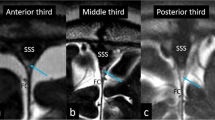Abstract
Purpose
The present study aimed to explore the subependymal layers overlying the cerebral ventricles using magnetic resonance imaging.
Methods
A total of 69 outpatients underwent constructive interference in steady-state (CISS) sequence in thin-sliced, coronal, and sagittal sections.
Results
The subependymal layers were delineated as linear hyperintensities, coursing along the outer margins of the ventricular walls. On coronal images, the hyperintensities surrounding the anterior horn of the lateral ventricle were identified in 97% of patients, while those of the third ventricle were identified in 96% of patients. In the trigone and posterior horn of the lateral ventricle, the hyperintensities were delineated in all patients. On sagittal images, subependymal hyperintensities were identified in all. At the level of the anterior horn and third ventricle, the subependymal hyperintensities were found to communicate with the Virchow-Robin spaces (VRSs) in 68% and 65% of patients, respectively. At the level of the trigone and posterior horn of the lateral ventricle, the VRSs communicated with the subependymal hyperintensities in 83% of patients.
Conclusions
Subependymal hyperintensity may represent an inflow passage of the VRSs that jointly contribute to efficient transependymal migration of the interstitial fluid into the ventricular cerebrospinal fluid.








Similar content being viewed by others
References
De León GA, Girling DJ (1975) Cystic degeneration of the telencephalic subependymal germinal layer in newborn infants. J Neurol Neurosurg Psychiatry 38(3):265–271
Held P, Fründ R, Seitz J, Nitz W, Haffke T, Hees H, Waldeck A (2000) Comparison of a T2* w. 3D CISS and a T2 w. 3D turbo spin echo for the anatomical study of facial and vestibulocochlear nerves. J Neuroradiol 27(3):173–178
James AE Jr, Strecker EP, Sperber E, Flor WJ, Merz T, Burns B (1974) An alternative pathway of cerebrospinal fluid absorption in communicating hydrocephalus. Transependymal movement. Radiology 111(1):143–146
Leonhardt H, Desaga U (1975) Recent observations on ependyma and subependymal basement membranes. Acta Neurochir 31(3-4):153–159
Llewellyn G, Gaudet L, Quartey GR, Campbell DR (1984) Intracranial metrizamide following myelography. J Can Assoc Radiol 35(3):259–261
Malm J, Kristensen B, Ekstedt J, Adolfsson R, Wester P (1991) CSF monoamine metabolites, cholinesterases and lactate in the adult hydrocephalus syndrome (normal pressure hydrocephalus) related to CSF hydrodynamic patterns. J Neurol Neurosurg Psychiatry 54(3):252–259
Marinković S, Gibo H, Filipović B, Dulejić V, Piscević I (2005) Microanatomy of the subependymal arteries of the lateral ventricle. Surg Neurol 63(5):451–458
Masdeu JC, Pascual B, Bressi F, Casale M, Prieto E, Arbizu J, Fernández-Seara MA (2009) Ventricular wall granulations and draining of cerebrospinal fluid in chronic giant hydrocephalus. Arch Neurol 66(2):262–267
Mokrý J, Cízková D, Osrerreicher J (2004) Subependymal zone: immunohistochemically distinct compartment in the adult mammalian forebrain. Acta Med (Hradec Kralove) 47(4):235–242
Nicolasjiwan M, Lopes MB, Larner J, Wintermark M, Schiff D (2012) Subependymal seeding of low-grade oligodendroglial neoplasms: a case series. J Neuro-Oncol 108(1):99–108
Ogata J, Hochwald GM, Cravioto H, Ransohoff J (1972) Light and electron microscopic studies of experimental hydrocephalus. Ependymal and subependymal areas. Acta Neuropathol 21(3):213–223
Ringstad G, Vatnehol SAS, Eide PK (2017) Glymphatic MRI in idiopathic normal pressure hydrocephalus. Brain 140(10):2691–2705
Steindler DA, Kadrie T, Fillmore H, Thomas LB (1996) The subependymal zone: “brain marrow”. Prog Brain Res 108:349–363
Sun X, Liang C, Liu C, Liu S, Deng K, He J (2010) Oculomotor paralysis: 3D-CISS MR imaging with MPR in the evaluation of neuralgic manifestation and the adjacent structures. Eur J Radiol 73(2):221–223
Torack RM (1980) Ultrastructural studies of subependymal extracellular spaces in adult and neonatal rat brain. Histochemistry 68(3):297–307
van Veluw SJ, Fracasso A, Visser F, Spliet WG, Luijten PR, Biessels GJ, Zwanenburg JJ (2015) FLAIR images at 7 Tesla MRI highlight the ependyma and the outer layers of the cerebral cortex. Neuroimage 104:100–109
Vannier A, Gray Y, Gherardi R, Marsault C, Degos JD, Poirier J (1986) Diffuse subependymal periventricular metastases. Report of three cases. Cancer 58(12):2720–2725
Wardlaw JM, Benveniste H, Nadergaard M, Zlokovic BV, Mestre H, Lee H, Doubal FN, Brown R, Ramirez J, Maclntosh BJ, Tannenbaum A, Ballerini L, Rungta RL, Boido D, Sweeney M, Montagne A, Charpak S, Joutel A, Smith KJ, Black SE, colleagues from the Foundation Leducq Transatlantic Network of Excellence on the Role of the Perivascular Space in Cerebral Small Vessel Disease (2020) Perivascular spaces in the brain: anatomy, physiology and pathology. Nat Rev Neurol 16(3):137–153
Author information
Authors and Affiliations
Contributions
Satoshi Tsutsumi and Hideo Ono developed the study project.
Hisato Ishii collected and managed the data.
Satoshi Tsutsumi and Hisato Ishii analyzed the data.
Satoshi Tsutsumi wrote the manuscript.
Corresponding author
Ethics declarations
Conflict of interest
The authors have no conflicts of interest concerning the materials and methods used in this study or the findings presented in this manuscript.
Additional information
Publisher’s note
Springer Nature remains neutral with regard to jurisdictional claims in published maps and institutional affiliations.
Rights and permissions
About this article
Cite this article
Tsutsumi, S., Ono, H. & Ishii, H. Subependymal hyperintense layer on CISS sequence: An MRI study. Childs Nerv Syst 37, 147–152 (2021). https://doi.org/10.1007/s00381-020-04707-2
Received:
Accepted:
Published:
Issue Date:
DOI: https://doi.org/10.1007/s00381-020-04707-2




